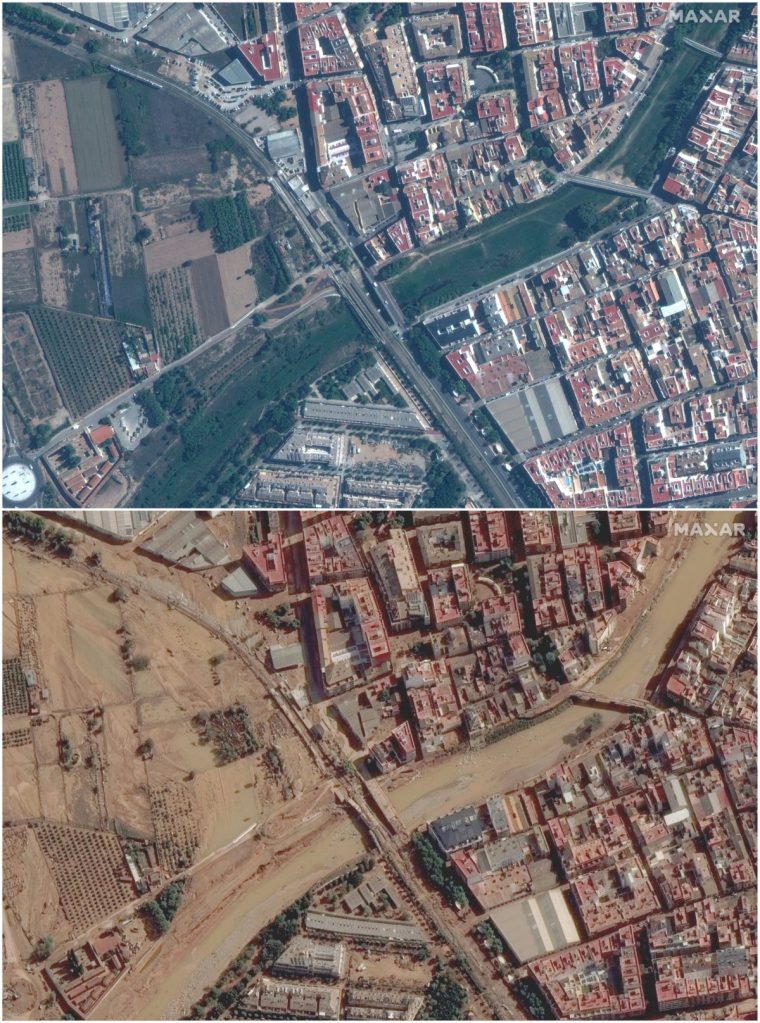The death toll from the devastating Spain floods could rise further, as emergency teams continue to conduct house-to-house searches in the worst-hit parts of the Valencia region.
It follows the region’s worst flood in living memory, with bridges and cars swept away as rivers burst their banks after more than a year’s worth of rain fell within just eight hours in some parts of country.
At least 205 people have been confirmed dead across Spain.
Scientists say the intensity of the storm was compounded by climate change, while political fallout is underway, with left-wing politicians blaming Valencia’s conservative regional mayor for downplaying the threat of the approaching extreme weather.
Here is a timeline of what happened…
How did the Spain floods unfold?
Tuesday 29 October
- 5.42am: Heavy rainfall brings flash floods to southern and south-eastern Spain, particularly the Valencia region. The State Meteorological Agency (AEMET) issues an orange weather warning for the south of Valencia, before the port of Valencia announces its closure.
- 6.36: AEMET, Spain’s meteorological service, issues a red weather warning for the Valencia region, and upgrades the previous warning to the highest level an hour later.
- 10.30am: The ravine in Chiva overflows, flooding the municipality to the west of Valencia city, with nearly 500mm of rainfall recorded by the end of the day. Many of the surrounding towns of Valencia were worst hit, as they lay unprotected by the riverbed for the Turia, which was built in the 1950s to protect the city from flooding.
- 10.45am: Emergency services issue an alert to municipalities along the Magro river west of Valencia city. Fifteen minutes later the Magro bursts its banks in Utiel, which at this time has received 200mm of rainfall. Minutes later, emergency services alert municipalities along the Poyo ravine.
- 12pm: Valencian President Carlos Mazón holds a press conference, claiming the storm’s intensity will decrease by 5pm. Criticism will follow as opposition politcians hold Mr Mazón responsible for later fatalities.
- 4.35pm: Emergency services issue alerts in the towns surrounding Valencia, as the Magro and Júcar rivers begin to overflow. An hour later the Poyo bursts its banks in Torrent, flooding several towns in Horta Sud. Multiple fatalities are already reported as people seek shelter on the Autovía V-30 and in shopping centres.
- 6:25pm: A bridge in Picanya is destroyed by floodwaters. Forty-five minutes later The Valencian regional government issues an SMS alert, advising residents to stay indoors. The Spanish government receives a request for Military Emergencies Unit (UME) intervention in the Valencian Community.
- 8pm: Mr Mazón reappears, declaring the floods an “unprecedented situation.” At around midnight his team allegedly deletes a post on X predicting the storm would dissipate.
Wednesday 30 October
- 8am: The heavy rain overnight begins to subside, and the scale of the disaster emerges. At this point, the death toll stands at 51, with many more feared dead as rescuers frantically search for missing people.
- 11am: Spanish Prime Minister Pedro Sánchez makes a televised statement, warning that “we mustn’t let our guard down” as the weather front continues to cause destruction. He warns people to continue to take special care. “There are still weather warnings in Andalucía, Valencia, Aragón, Castilla y León, in Cataluña, in Extremadura, in Navarra, in La Rioja and in Ceuta.”
- 2pm: Three days of national mourning are declared, from 31 October to 2 November. The death toll rises to at least 72, according to government sources reported by El País.
- 3pm: More than 1,000 troops are deployed for rescue operations. Flooding has caused major infrastructure damage, swept away cars and derailing a high-speed train with nearly 300 passengers onboard, though no injuries are reported.

What has happened since?
Spain’s railway operator, Administrador de Infraestructuras Ferroviarias, announced the suspension of all rail services in Valencia until conditions improved. Heavy rain and winds led to the diversion of 12 flights from Valencia Airport, while 10 other flights were canceled.
The surge in emergency calls overwhelmed the response system, forcing some residents to seek help via social media, according to El País.
The Military Emergencies Unit was deployed to assist with rescue operations after the Spanish government established a crisis committee. Helicopters saved residents trapped near a swollen river in Álora, Andalucía.
Financial losses are predicted to surpass those of the 1983 Spanish floods, marking this as potentially the costliest disaster in Spanish history. Utiel Mayor Ricardo Gabaldón noted that floodwaters reached three metres high in the town.
The regional government of Valencia came under heavy criticism for allegedly failing to prepare sufficiently for the flash floods. he right-wing regional government under Carlos Mazón abolished Valencia’s emergency unit when he took office in 2023.
“There are governments that privatise and dismantle when they arrive in institutions, and there are governments that are proud of that,” said Gabriel Rufián of the Catalan Republican Left.
Professor Liz Stephens, a professor of climate risks and resilience at the University of Reading, said: “People shouldn’t be dying from these kinds of forecasted weather events in countries that have the resources to do better.
“Climate scientists have been warning for years that climate change will lead to more intense rainfall. The tragic consequences of this event show that we still have a long way to go to prepare for these kinds of events – and worse – in the future.”


